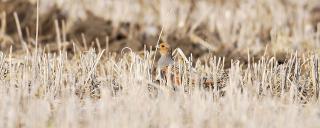
Gray Partridge Habitat
General Information
Most North Dakotans know this bird as the Hungarian partridge or Hun. Gray partridge are plump birds with short, rounded wings and short tails. Adults are 12-13 inches long and weigh 3/4 lb. to 1 pound. The breeding season begins in late February when birds pair. Nesting begins in late May with nests in shallow scrapes lined with dead herbaceous vegetation. Most nests are placed in hayfields, native grasslands, roadsides and other idle areas. Clutches contain 15-17 eggs and incubation is shared, but the majority is done by the female. If nests are destroyed, partridge are persistent renesters and may make up to three attempts to renest. Chick mortality is high and may be intensified by cold, damp weather at time of hatching. Partridge are sedentary and rarely move more than one mile except during the mating season. Family groups remain together during fall and winter, and covey mixing does occur. Coveys break up in late winter with the onset of the reproductive season. Partridge tolerate North Dakota winters fairly well when adequate habitat and food are available. Addition of fat and dense plumage, along with thick foot pads, allows the birds to survive freezing temperatures. They also may tunnel through snow in search of food where they are protected from the wind.
General Habitat Requirements
Partridge tolerate moderately intense agricultural practices and are associated with areas of small grains and fertile soils in combination with adequate nesting and brooding cover. As an edge generalist species, partridge depend on a combination of hay and grain fields, fencerows, rights-of-way and farmsteads. Their diet consists of small grains, weed seeds and green vegetation. As with most game birds, young require protein-rich foods during their first summer to meet the demands of rapidly growing bodies and feathers. Insects are important to their survival from hatching to four to five weeks of age. Winter is a time of food scarcity and grain and sunflower stubble, roadsides, and farmsteads all play an important role in survival as grains, weed seeds, sprouts and grit lay exposed and are readily accessible.
Management Considerations
- Delay cutting grasslands (nesting habitat) until after the primary nesting season (April 15 through August 1).
- Plant mixtures of short- to mid-grasses and forbs in reclaimed croplands, land retirement acres (CRP) and grassland restoration areas.
- Use prescribed grazing plans to eliminate overutilization of woody draws, mesic swales and riparian areas.
- Use prescribed burning where necessary to control woody vegetation and rejuvenate decadent grass stands.
- Control noxious weeds to prevent their domination of grasslands and rangelands.
- Conscientious use of pesticides (e.g., least toxic to birds, minimize negative impacts to desirable habitat, target pests instead of broad scale application, Integrated Pest Management).
- Avoid fall tillage methods to retain plant residue on the surface.
- Control tall woody vegetation, including single trees that act as raptor perches and raptor nest sites.
- Use flushing bars, avoid night mowing and cut hay fields from the center outward or toward undisturbed habitat.
